The Red-Eared Slider is one of the most popular pet turtles around.
Their small size, unique patterns, and docile personality make them a great choice. It is almost impossible to find a turtle as interesting and affordable. Red-Ears are also some of the most active and interesting turtles. They can be a great addition to any home willing to put in the effort.
You are watching: Red-Eared Slider: Care, Diet, Habitat, Tank, & Facts
However, anyone considering a slider must know they need a significant amount of care. This is a pet that will last for decades and grows much larger than their tiny quarter-sized baby weight.
Does this turtle seem like a fun and interesting pet?
Keep reading to learn the ins and outs of their care to decide if it is the right turtle for you…
About Red-Eared Sliders

Red-Eared Sliders (Trachemys scripta elegans) are a subspecies of the Common Slider (Trachemys scripta) which is one of three North American Pond Sliders. Some other subspecies of the pond slider include the yellow-bellied slider and the Cumberland.
The most attractive feature of this turtle is its appearance. These Sliders are known for their distinct red stripes behind each ear. They range in color from dark green to brown, with yellowish ribbons all over their green bodies and along the edge of their dark olive-green shell.
This turtle is perfect for beginners because they are cheap, easy to breed, and small in size.
Teenage Mutant Ninja Turtle Species
If this was not enough, in 2018, Leonardo from Teenage Mutant Ninja Turtles was officially confirmed to be a Red-Eared Slider. This increased their popularity among children.
Unfortunately, their popularity with inexperienced keepers has caused many to be released in the wild.
They are the most popular turtle in the world in the pet trade. Between 1989 and 1997 52 million were exported from the United States. That’s just exported out of the US!
A Turtle Is Not Just For Christmas
Many red-eared sliders have since been released outside of their native range, either as abandoned pets or as part of rituals.
As a result, the Red-Eared Slider has become one of the most invasive species and can be found on every continent except Antarctica. Breeding populations have been discovered in a variety of new US states, European countries, Asia, Australia, the Middle East, and Central America.
Its presence in non-native areas causes significant problems for wild turtle populations, as they can easily outcompete native turtles and other native species for resources. Because of this, in areas such as Oregon, you need a permit to keep one.
According to the Global Invasive Species Database, they pose an extreme risk, not just to native turtle species, but to other native wildlife and even humans.
So it’s important that you should understand the care any Slider needs before adopting one.
Like most aquatic turtles, they need an aquarium with plenty of space, décor, and perches. Heat and UVB are also essential, so fixtures and thermostats are needed to create a suitable habitat. It can be difficult for first time keepers to set up and maintain a proper tank for these turtles.
These small, beautiful and active turtles can be very rewarding. However, consistent care is important to maintaining their health.
Are Red-Eared Sliders Good Pets?
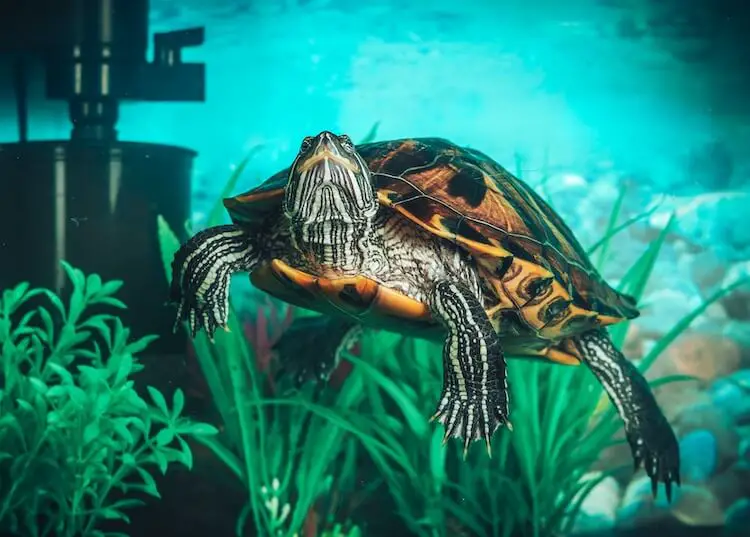
Red-Eared Sliders can be fun and interesting pets to watch. They need lots of space and are generally better pets for more experienced turtle enthusiasts. However, if a beginner owner can provide adequate space, they can also keep one. With the right setup and proper care, they make a great pet!
How To Take Care Of A Red-Eared Slider Turtle
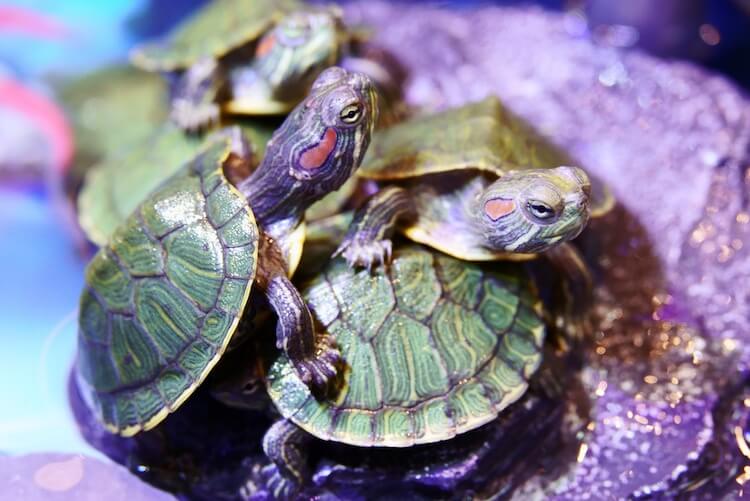
Red-Eared Sliders need lots of space and many live for well over 20 years. First-time turtle owners should do their research before acquiring this species. This turtle is better suited for individuals with more experience in handling and rearing turtles but properly informed beginners can enjoy them.
In general, you will need to provide specialized heating, UVB lights, décor, clean water, proper nutrition, and both swimming and basking areas. This means that setting up and maintaining the enclosure is not only expensive but can also be time-consuming for the average person.
The intensity of the work required can vary depending on the overall setup of your enclosure. However, with effort and patience, most people can learn to properly care for these popular pets.
Red-Eared Slider Habitat
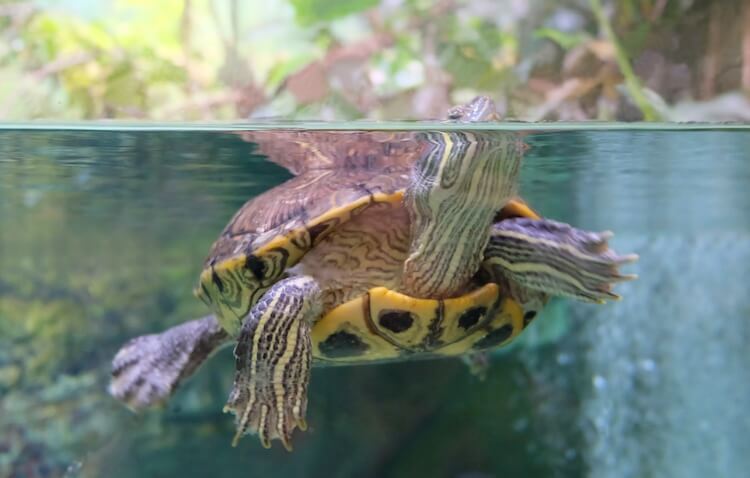
Yellow-Bellied Slider In An Aquarium.
Semi-Aquatic or Aquatic Turtles
Semi-aquatic reptiles live partly in water and partly on land. Aquatic reptiles live totally in water, with the exception of coming ashore to lay eggs.
Sliders are semi-aquatic turtles from fresh and brackish water ecosystems. They spend the majority of their time either in the water foraging or basking on rocks and logs.
They prefer shallow, muddy water pools with logs for basking. In the wild, these turtles inhabit freshwater areas with still or slowly flowing water. Many live in ponds, lakes, streams, creeks, or swamps. If the water dries up, they will even travel in search of more water.
It is important to mimic this as closely as possible when you set up their tank. They need water to swim in, logs and perches to bask on and a UVB bulb to provide artificial sunlight. It is also important to choose the best décor and substrates to promote natural behaviors and prevent boredom.
Tank Size, Heating, Lighting, and Setup
Red-Eared Slider turtles are most commonly kept in glass or acrylic aquariums, although they can also be housed in stock tanks or outdoor ponds. If you use a metal stock tank, you will need a pond liner to prevent chemical leakage into the water.
These turtles require lots of space to live and swim.
An average-sized adult needs at least a 55-gallon tank. For every slider added, you should add at least 10 more gallons. One turtle should have at least two square feet of surface area. For each additional slider, you should add another square foot of surface area. If you have an especially large female, you should double these space requirements and use a 100-gallon aquarium.
A good rule of thumb is that the tank should be 5x the length of your turtle, 3x as wide and at least 2x as tall.
Read more : Fall Themed Birthday Party
Heating and lighting, are equally as important to the health of your slider.
As they are cold-blooded reptiles, indoor sliders need basking sites. They will need a UVB lamp over the basking spot.
Indoor sliders will need a UVB lamp over their basking spot. To avoid health complications, your turtle needs access to a tube-style, full-spectrum 10.0 UVB bulb. It is important to make sure that the logs and perches are placed within the high effectivity distance of the bulb. This light should be on 12 to 14 hours per day.
For the basking spot, you should use a material that your turtle can easily climb onto without scratching itself, such as cork or a smooth rock. Your basking spot should be at the water level.
You should set the basking spot temperature at 85 to 95℉. The ambient temperature towards the cool side should be between 75 to 80℉.
If the ambient room temperature is at or above 75℉, a UVB lamp over the basking spot is sufficient for heating. If not you can use a ceramic heat emitter or infrared heat bulb with a wattage that is appropriate for your tank.
Generally, the water temperature should be between 74 and 78℉
If the temperature is below 74℉, you will need a submersible water heater. You should use a thermometer to monitor the temperature of the water and not rely on your heater’s settings.
Substrate at the bottom of the tank is not necessary, but it can make your aquarium look nicer. However, it will make cleaning more difficult, so many keepers choose to avoid substrate in turtle tanks.
If you would like to include a substrate, the best option is river pebbles. Just make sure that they are not small enough to be swallowed, as this can harm your slider.
With décor, less is more. You want your turtle to have plenty of room to exercise freely. Aquatic plants can be used, but your turtle might eat them or uproot them. Large rocks or driftwood pieces can be used to create a dynamic swimming environment. If you use large river rocks, make sure that they are smooth and won’t injure your slider. You can secure rocks into your enclosure with a nontoxic aquarium sealant.
Finally, remember to install a filter capable of cleaning the aquarium. Between food waste and fecal matter, these tanks can become dirty quickly and lead to health issues.
Purchasing an aquarium, UVB light and fixture, heat lamp and fixture, thermometers and thermostats, water heater, décor, and a high-quality filtration system will cost $400 to $700. This may seem expensive, but these items are essential to your turtle’s health.
How Long Do Red-Eared Sliders Live?
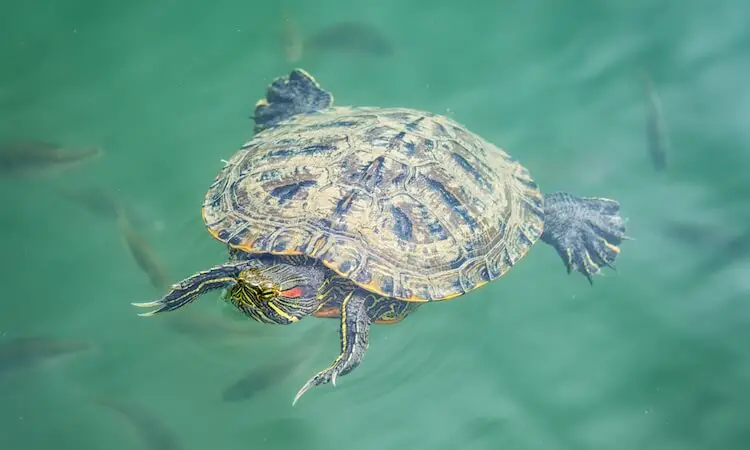
Red-Eared Sliders are capable of living for decades. In the wild, red sliders can live from 20 to 50 years. Pet turtles typically don’t live as long, but you can expect your turtle to live between 20 to 30 years with good care.
It is quite common for Sliders to get sick because of husbandry-related issues like shell rot, skin ulcers, respiratory problems, conjunctivitis and metabolic bone disease. Many reptile veterinarians treat Red-Eared Sliders with illnesses that could easily have been prevented with proper care.
Shell rot and skin ulcers are typically caused by poor enclosure maintenance or a lack of heat.
Without regular water changes and cleaning, these turtles are at an increased risk of developing smelly, rotting sores on their shells and skin. Shell rot is a bacterial or fungal infection, which often shows as a light-colored spot on the shell. This infection can spread to other parts of your turtle’s body, so it is very important to get it treated as soon as possible.
To help maintain clean water, use a filter capable of cleaning tanks five times the size of the one you are using to account for the increased fecal and food waste in an aquatic turtle tank. Partial water changes with water testing are also essential, but time-consuming.
Like most other pet reptiles, Red-Ears require Ultraviolet B (UVB) lighting along with their calcium supplements to grow and develop properly. If they are kept outdoors, they will receive UVB rays from the sun, but if they are kept indoors, you will need to implement a UVB lamp.
Without UVB lighting they will develop deformities, soft bones, and soft shells.
Finally, if a Red-Eared Slider is not able to bask and reach a proper body temperature, they can have digestion issues and lose their appetite. Some turtles may swim lopsidedly, as congestion distorts the turtle’s balance.
These health issues are all simple to prevent with proper husbandry and diet.
What To Feed A Red-Eared Slider
Red-Eared Sliders are omnivores with a wide variety of food preferences.
In the wild these little turtles spend most of their time eating aquatic vegetation, invertebrates, tadpoles, and fish. Sliders have a sharp, ridged beak to help them tear up vegetation and use their highly developed vision to find prey.
Juvenile turtles eat a mostly carnivorous diet, but adults eat plant matter and aquatic vegetation. This can easily be recreated in captivity if you adjust your turtle’s diet as it ages.
Aim to feed your young turtles a diet of 70% protein five days a week. To ensure a proper diet, make sure to also offer greens for them to graze on. Adults should be fed a diet of 20% protein by only feeding prey twice a week. Greens should be offered every day.
Some good foods include:
Leafy Greens Vegetables Fruits Protein
- Kale
- Spinach
- Mustard Greens
- Dandelion Greens
- Romaine lettuce
- Collard greens
- Carrots
- Sweet potato
- Green beans
- Broccoli
- Squash
- Apples
- Pears
- Berries
- Melon
- Frozen bloodworms
- Mealworms
- Earthworms
- Crickets
- Boiled meat/poultry (chicken, beef, shrimp)
- Pinkie mice
- Shrimp
- Feeder fish
- Krill
However, you should not feed your slider the following:
- Raw or processed meats
- Chocolate
- Fireflies
- Avocados
- Onions
If you want to feed fish, then avoid fatty species like goldfish and always feed them fresh, captive-bred fish. Frozen fish can sometimes build up toxic levels of enzymes, and any wild prey can carry parasites.
Be cautious with fruits and only use them as treats since they can cause diarrhea in reptiles.
You should supplement their diet with a multivitamin to ensure your turtle is getting a well-rounded diet. A multivitamin with calcium and vitamin D3 can be added to meals twice a week. You can also offer high-quality nutritional pellets, but this should not exceed 25% of their diet.
Red-Eared Slider Turtle Facts
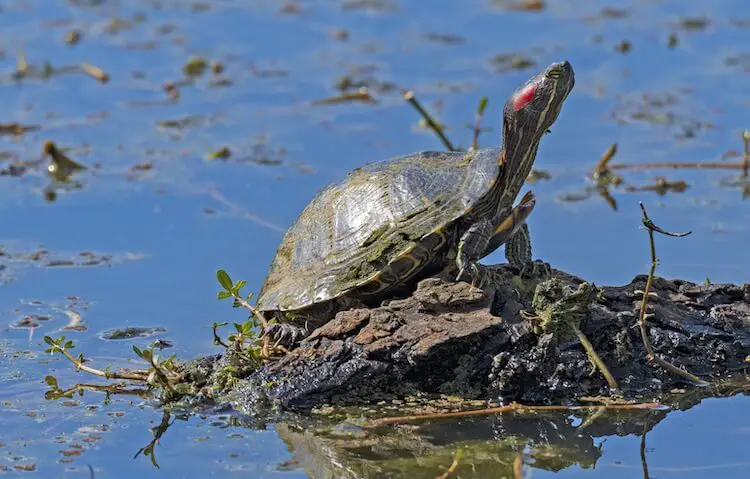
Read more : Nema Rating Buying Guide
Facts Table Common Name (s) Red slider turtle, red-eared slider, red-eared terrapin Scientific Name Trachemys scripta elegans Family Name Emydidae Genus Name Trachemys Native Range South-central United States Adult Size 8 to 13 inches Lifespan 20 to 30 years Price $20 to $50 Similar Species Yellow-Bellied Slider, Eastern Box Turtle, and Three-Toed Box Turtle
Buying Guide
Red-Eared Sliders are invasive in most parts of the world. It is important to research your local wildlife laws to determine if you can legally purchase one in your state. Their invasive nature also makes finding a reputable breeder difficult.
You can get a Slider from pet stores, breeders, large-scale dealers, or rescue organizations. Generally, breeders will be the most knowledgeable of their turtles’ histories. If someone is trying to sell you hatchlings less than four inches long, you should not purchase from them. The sale of turtles less than four inches is illegal in the U.S.
If you are struggling to find a breeder, consider adopting a Red-Eared Slider from a rescue or facility that collects invasives.
When choosing your turtle, look for signs that they are healthy. The Slider should be active and have quick reflexes when approached or prodded. If you pull at one of their legs (gently), you should receive a strong response. If they are approached, they should slide into the water.
The shell should be smooth, hard, and not have any dark or light spots. The shell should also not have any scratches or other damage.
Make sure the eyes aren’t cloudy at all and examine the shell and skin for any sores or growths. If the turtle is active, healthy, and clean, then bring it home!
Appearance
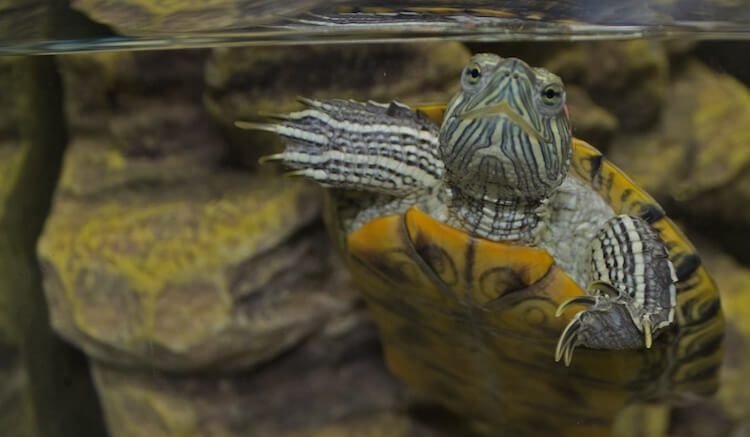
Sliders are beautifully patterned pond turtles. Unlike any other pond turtle species, Red-Eared Sliders have a defining maroon-red stripe behind each ear. This feature separates them from all other species and makes them very easy to spot.
Red-Eared Sliders have olive green-brown carapaces, or “top shells”, that are divided into plate-like sections called “scutes.” As they age, the shell may turn darker, becoming almost black. The scutes along the edge of the shell are outlined in a bright yellow. The plastron, or “bottom shell”, is a bright yellow with a single dark, round blotch on each belly scute. Their shells are also more dome-shaped than other flat-shelled turtles.
Their legs, head, and tail are a dark green color with yellow stripes.
Some turtles can come in pastel and albino morphs, although these colorings are not usually seen in the wild.
The pastel variety has similar markings to the Red-Eared Slider but is paler in color. The albino variety can appear almost entirely yellowish-white, except for the red stripes behind the eyes.
Size
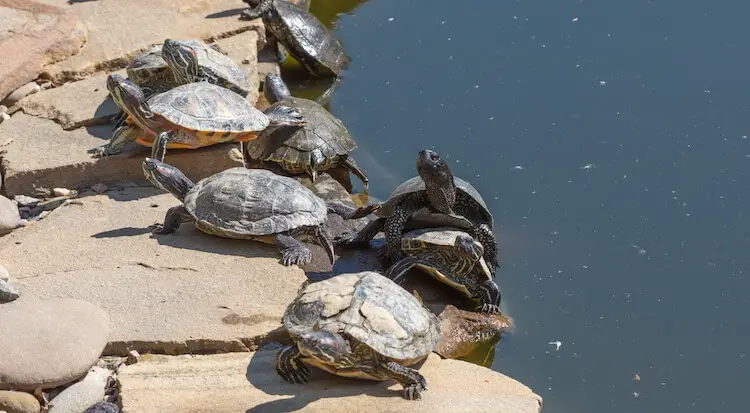
Hatchling Red-Eared Sliders are absolutely adorable. They are barely larger than a quarter, which makes it even more incredible to learn that the average adult is 5 to 12 inches across the shell.
When they first emerge from their eggs, hatchlings are extremely small, at about one inch in length. Females will grow to be around 10 to 12 inches in length, and males tend to be on the smaller end of the spectrum, most never reaching more than eight inches long.
Females reach sexual maturity at between 6 to 8 inches in carapace length and 5 to 7 years in age. Male red-eared sliders reach sexual maturity at between 3 to 4 inches in length and 3 to 5 years in age.
Males and females are also easily distinguished by appearance. Males have a longer, thinner tail and much longer fingernails on the front legs. Females have much shorter nails for nest digging.
Adult Red-Eared Sliders can be sexed primarily by the difference in size between the full-grown male and female. Hatchlings are not easily sexed.
Normal Behavior

Red-Eared Sliders are active turtles that spend most of their time swimming, foraging, and basking. They are normally found basking in groups and communicate with one another through touch and vibration.
When basking, these turtles lookout for predators and can dive into the water at a moment’s notice. If they happen to be on land, they can pull in their arms and legs to protect themselves too.
Wild Sliders are aggressive and competitive, especially when feeding. They compete both within their own species and with other turtle species. If two turtles attempt to eat the same food, they will use gaping gestures, bite and push. Open-mouth or gaping gestures, especially if they are aimed at other turtles, are a sign of aggression. However, pet turtles tend to be more passive.
As a pet, they will spend much of the daytime basking on a perch directly beneath the basking heat source. If you notice that your turtle is avoiding the heat, that could be a sign of issues.
Aside from basking, they will also dive into the water to explore frequently. Healthy Sliders tend to be alert, curious, and inquisitive.
Handling A Red-Eared Slider
Red-Eared Sliders can be handled safely, but many are intolerant of frequent handling.
If they feel threatened they may retreat into their shells and bite at you. If your turtle reacts in this way, it is best to reduce handling. However, some Sliders may feel comfortable being handled.
When picking up your turtle, place your hand behind them and grip the top and bottom of their shell directly in line with the tail. Hold them as you would a hamburger. If your Slider is still scratching you, place them back in the enclosure and try handling again after your turtle has calmed down.
Before and after handling you should consider your own health.
Red-Eared Sliders are known to be carriers of salmonella, so hand-washing before and after holding is necessary to prevent spreading disease.
Summary
Keepers love these turtles for their high activity levels and beautiful yellow, green and red colors. Their delicate redhead markings make them very cute pets.
These hardy turtles adapt very well to life as pets, and with good care, your turtle could live to be 20 to 30 years old.
As they are very common pets, they can easily be bought. But, you should do your homework to make sure you are purchasing from a reputable source and following your local laws.
Before purchasing, also consider the effort it takes to keep them healthy over their lifespan. The widespread popularity of these turtles has led to them being released into the wild, putting pressure on ecosystems around the world.
If the Red-Eared Slider has caught your attention, don’t forget to let us know in the comments below!
Source: https://gardencourte.com
Categories: Outdoor


